30
Progressive Thinkers as of 5/8/2020
|
| ||||||||||||||||||||||||||||||||||||||||||||||||||||||||||||||||||||||||||||||||||||||||||||||||||||||||||||||||||||||||||||||||||||||||||||||||||||||
When confronting the idea of a Standard Cognitive pattern or profile, a researcher might necessarily look for others doing research with these same words in mind. However, it can soon be discovered that not everyone uses the words in the same manner nor with the same intent. However, more often than not a researcher puts a heavy reliance on language. The trouble with using language and perhaps turning to linguistics for some insight into standard or basic patterns that one might begin further research for their specific interest is that Linguists tend to overlook one key component. This key component is the ear and how we hear. Linguist after linguist after linguist fail to take into consideration the processes of hearing... and to argue otherwise is to try to conceal an absent of such a discussion from their often over-value theory. It is an embarrassing oversight that not even philosophers have made comment about in their evaluations of language and thought processing. Whereas philosophers know all too well about monism, dualism and triple formulas, none of them are even making a small reference to the ear and hearing. And no matter how many times one may have encountered the phrase "lend me your ears", the ear and the processes of hearing have not typically been included in the presumed erudite research positions.
Shame on all of you. it is time for you to make amends... as well as amending your theoretical positions accordingly. While many of your are aware of the recurring presence of patterns-of-three such as those in Fairy tales, Mythology and Religion, such subjects tend to incline observers to concluding such a pattern is to be interpreted in the same manner as one does such subjects... with questionable importance and only valid as a tool for selling a product, keeping one's attention due to a short attention span of most people, or as a useful tool for the occasional joke, such as those involving three characters. Such a pattern may not cross the mind of a person thinking themselves to be a serious researcher to take such a pattern seriously. To look at, look for and catalog patterns-of-three from different subjects is tantamount to engaging in superstition, numerology, or some whimsical, quirky, pastime like making a ball of string, stringing beads or trying to pull grey hairs out of one's scalp as an attempted means of staying young.
It should actually be needless for me to say that speech would be difficult without an ability to hear, and thus the act, the process, the design of hearing should be taken into account when speaking of language. While the pattern-of-three Word Order (Subject- Object- Verb) is discussed; and the patterns of three occurring in the ear are in the realm of some oblivion for most researchers as is the fact that apparently... most people hold a writing instrument such as a pen or pencil with three fingers. All the intense scrutinizing researchers are overlooking some of the most obvious exercises of language production and illustration. All our grand-standing language theories disinclude to contain even a lip-service token of acknowledging the recurring patterns to be found with the form and functionality of hearing.
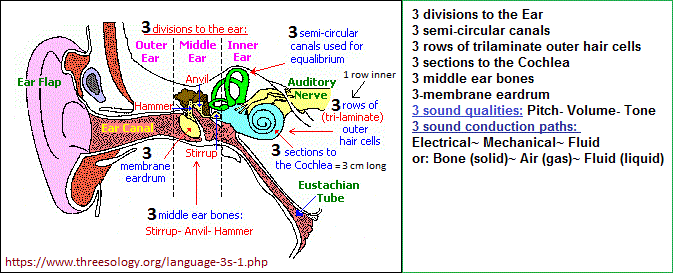
The foregoing illustration of the ear's patterning can be viewed as a blueprint of a working model that can be replicated as a mechanical engineering
exercise. Interestingly, it also has application to the physics double-slit experiment model. There is a cognitive parallel here that needs to be further
investigated. Both of them are devices which present an input and output relevancy.
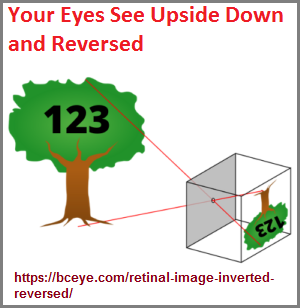 For example, if we alter the design of the ear model to (for example) a pattern-of-two structuring, would this equate to the presence of more pattern-of-two
being expressed (outputted)? And because we already find multiple ideas exhibiting patterns-of-two, does this mean there is dysfunction from a device
constructed with patterns-of-three, or the mechanism of interpretating (the brain/mind as a processor) is out-dated (not evolved) and needs to be upgraded?
And if we were to alter the design of the ear to have a four, or five, or six, or seven, or eight, or nine, etc... pattern? Is the brain-as-a-processor too
slow... too ill-equipped or too restricted by diet, by beliefs, by social standards, (etc...)? And if we view the double-slit experiment as a type of
"hearing" apparatus involving a sighted-processing model, how does this measure up to the form and functionality of an actual eye with its three cones of
color, flip-flopped inversion (upside down, reversed and condensed model is seen of the actual), as well as the three-patterned cornea-pupil-iris formula, not
to mention three currently known types of photoreceptor cells in mammalian eyes: 1) rods, 2)
cones, and 3) intrinsically photosensitive retinal ganglion cells.
For example, if we alter the design of the ear model to (for example) a pattern-of-two structuring, would this equate to the presence of more pattern-of-two
being expressed (outputted)? And because we already find multiple ideas exhibiting patterns-of-two, does this mean there is dysfunction from a device
constructed with patterns-of-three, or the mechanism of interpretating (the brain/mind as a processor) is out-dated (not evolved) and needs to be upgraded?
And if we were to alter the design of the ear to have a four, or five, or six, or seven, or eight, or nine, etc... pattern? Is the brain-as-a-processor too
slow... too ill-equipped or too restricted by diet, by beliefs, by social standards, (etc...)? And if we view the double-slit experiment as a type of
"hearing" apparatus involving a sighted-processing model, how does this measure up to the form and functionality of an actual eye with its three cones of
color, flip-flopped inversion (upside down, reversed and condensed model is seen of the actual), as well as the three-patterned cornea-pupil-iris formula, not
to mention three currently known types of photoreceptor cells in mammalian eyes: 1) rods, 2)
cones, and 3) intrinsically photosensitive retinal ganglion cells.
Note: I have just begun writing the morning after arriving at a Winter retreat in Arizona. The time read 3:31 (MST) [2:31 Arizona time] as I got out of bed. The property I am on is like a playground for an active imagination. There are an assortment of tasks needing to be attended to which is quite accommodating to a mind suited for exploring divergent paths of inquiry. (11/1/2022)
The title of this may be interpreted by some readers to be misleading if they are not current with the progress being made by different people from different vantage points concerning an attempt to establish what they believe to be standards in thinking, so as to apply such standards to their respective interest, be it computer science, code breaking, psychology, Artificial Intelligence mapping, story writing, persuasion by speech making, advertisement, commercial enterprising, etc... Different people want to know if there are given patterns of thought or thought processing which will allow them to manipulate others, copy others, or think better than them. My interest is an attempt to catalog where we are and if there is a change in terms of growth and/or deterioration. I say deterioration in the thinking processes of humanity because it is subjected to an environment that is incrementally deteriorating and must adapt itself accordingly. However, the human ego that it is may not want to recognize deterioration because it sets into play (for them) a series of negative connotations they may not be adequately able to cope with. However, aside from the "routinely talked about" deteriorations involving the air, soil and all-around human caused pollutions, I am speaking more of three less often discussed incremental deteriorations thus listed as:
- The Sun is burning out, and is said to be on a course of expansion that will eventually engulf the innermost three planets (Mercury- Venus- Earth), which may or may not produce a greater habitability on Mars.
- The Earth's rotation is slowing, despite intermittent periods of measurement indicating an increase or no-change variations, involving changes with the molten core and the Earth's magneto effects.
- The Moon is receding (moving away); having an effect on tides... which is what I call the "washing machine effect" necessary and needed for life as we know it.
By studying the frequency of ideas and activities which express a "three" pattern, I have come to recognize it is not an isolated occurrence. And yes, it is absent in several occasions with the presence of one or more patterns which may or may not exhibit a quantity such as one, two, four, five, six, seven, eight, nine, etc... And yet, most quantities being expressed have a small quantity, with some number identities showing up more frequently than others. on several occasions I have found that a given person or group of people declare a given pattern exists and is used as a major indicator, but that other interpretations are possible. The initial emphasis may have been due to a given person's influence and their personal penchant for using a given number pattern because they felt it is sacred, traditional or some other such criteria that they may or may not have disclosed.
Not only are small quantities most frequent, but also a limited variety of such small quantities. Whereas all subjects may or may not make use of a sequential number system within its domain of activity, this is not a routine consideration being made at present by humans. Humans do not intentionally research subject material in an effort to identify whether or not a given sequence of numbers is being used when all ideas related to a given subject are tallied for consideration. This absence of effort in this regard while manifest, is largely overlooked and never spoken of as a recurring cognitive pattern. Similarly, as an analogy, the use of Mathematics to analyze mathematics is poorly understood, much less recognized as a relative bias since the underlying pattern of mathematics is one of dichotomy, and represents a Westernized exercise of the same Easternized cognitive activity seen in the yin/yang philosophy. In other words, the Mathematics of today (which was born in the West) is but a philosophically contrived elaboration of the dichotomies found in the old yin and yang perspective (which was a philosophically contrived Eastern born elaboration of dichotomies being obsessed over). And despite the Easternized cognitive attempt to evolve beyond the "2-patterned" dichotomies by way of the so-called I-Ching triads, what we see are embellished byads (there is no triple-line configuration, only a repeat of the one and two-line denotations). No less, we see a similar impotent effort on the part of the West to move its Mathematics philosophy beyond its likewise underlying obsession with dichotomies into a "three" development, by such excursions as the three-patterned Trigonometry (sine- cosine- tangent), Pythagorean theorem (A2 + B2 = C2), and the use of squared/cubed distinctions, not to mention the use of a Boolean logic (And- Or- Not) in a binary computer code environment an effort as well as the current application of the insect tripod gait for robotics and a hoped-for trinary (ternary) computing system to subjugate the present binary system.
A Philosopher (a title which befits everyone to some extent)... may at some time come to ponder on the extent to which we humans may know reality, and that beyond such a reality may be an existence to which we can not apprehend with any certainty, leading to the proposition by some that it is foolish to even try to think beyond that which human physiology denies our mental capacity to fathom. By using numbers... or let me more explicitly say the advent of counting followed by its elaborations known as mathematics, we might have an exercised analogy to thought processing and development. The enumeration of thoughts might well enable us to ascertain whether or not a repetition exists... or some might say a pattern... such as a sequence of numbers or perhaps even th semblance of an equation. Do smart people exhibit different patterns or are the patterns the same for all except applied in a different context... perhaps in a different order or set(s) arrangement?
For example, before the advent of any conceptualized quantity of "1" by any human, such an idea may well have been in use but not in any conscious way of attendance or direct communication thereof to others. Is not the concept of "one" a simple thing available to all life forms to express such in their own way? And for that matter, is not the concept of "2" likewise easily discerned by all life forms that may have an underlying biological process which utilizes a pattern-of-two such as in cell division? Is not the concept of foreground and background evident to all whose species-specific means of interacting with the environment utilizes one-for-one correspondences such as by way of pairing? Then what of three? Does it not logically follow and yet even after the conceptualization of "1" a life-form may initially be unable to grasp beyond it whereby the idea is manifested in such a way that we humans might describe it as much, more, many, heap, all, a lot, infinity, forever, cosmos, universe, etc...? All of which signify cognitive limits that primitive humans may have at first come face to face with during the development of a sequential counting exercise that also reveals itself in the sequential practice of an alphabet? And yet, if humans developed mentally to the point that their cognition eventually overcame each cognitive limitation, can not this be the case for an ability existing in other life forms whose ability to count is an interpretation being subjected to the egotism of humanity insisting it is superior?
Do any life forms besides humans exhibit an increased ability to count? Is it not possible that this is the case but the fact that humanity has not kept a record of counting ability of other life forms makes the distinction all the more difficult? If humanity suggests to itself it has and is evolving, can not this be the case for other life forms whose indications thereof are not recognized by humans because humanity is overly obsessed with itself in its many subject endeavors, and think to take for granted that life forms do not evolve a greater counting ability over time? And yet, humanity itself is cognitively stuck because it insists on looking in the direction of representing enumeration in terms of an infinity... instead of conceptualizing an exact quantification? Hence, the concepts of "infinity" and "Universe" are equivalent to the "many" description once used by primitive peoples whose counting ability can be generalized into the three-patterned statement of "One- Two- Many", whether or not you... as a would-be historian or interested lay person in the development of counting likes the phrase or not? If not this phrase to express an appreciation that early peoples were confronted by cognitive limits in their efforts to develop a counting system, you prefer one- two..., or one- two- heap, or some other two- or three-patterned signification appropriate to your language preference or alternative subject interest with its respective lingua franca.
One might imagine a primitive human in the very distant past holding on to a bone and clinging to it with an ownership which denied its occupation to one or more others. Let us say it was a specific, singular bone or stone, or piece of food or place by a water source... etc... It's claim as belonging to someone implied it as a "1" item, even if it did not become articulated with any repeated grunt, growl, stare, or flinging of the arms. Nonetheless, the origin for the concept of singularity may have been initiated in such a fashion over multiple years or even decades... passing through multiple generations of those who repeated the behavior. In any event, the quantity of "1" became established which may or may not have been accompanied by a select (singular) word. And yet the point to be made in the analogy is that there was an absence of the concept of "2" as a quantity. It was beyond the common ken of the clan. Even though a practice of pairing, matching, combining or doubling (etc...) may have occurred, it too followed the cognitive trend to which the value of "1" had been experienced.
This is not to say that some individual(s) did not have the concept in their mind, it's just that the idea was not a commonality spoken of. Since to think differently in a tightly nit social group may have meant to do as the leaders instructed... which included sharing in their views, be they forward, backward or sideways thinking (horizontally, vertically, diagonally). Even if a leadership was neurotic, psychotic, socio-pathic, bipolar, schizophrenic, sadistic, masochistic, "multi-personalied", superstitious, fearful, etc..., this may have been the standard to which all members of the clan, tribe, group, gang... would have been expected to mimic. Those who thought differently, just as we have seen in later human civilizations, might well have had to be freed of their demons (such as through trephination), burned at the stake, ostracized, tortured, murdered, etc...
In effect, those who think differently and are not strong enough physically, or creatively, or mentally, or socially, or financially, or artistically, etc., able to defend themselves, may well be subjected to insults amounting to the declaration that one is losing or has lost their mind. Whereas all of us throughout our lives "lose our mind" as we develop and learn though we use words such as maturity, education and experience to define transitions of change which may take multiple years; those who experience a leap of consciousness over a short period of time or even seemingly instantly, may become overwhelmed by the inrush of ideas and associated feelings which sprout in reaction to, that they appear to be "unsettled" or "having a fit", unless such words as "Eureka!" "Revelation", "Inspiration", "intuitive grasp", "unrepentant belief", etc., are used in a positive manner to label a person whose excitement may not be easily quelled or kept from causing too much social disruption in a setting where such "loses of mind" are understood in a larger, more generously interpreted context. Indeed, one must lose their mind in order to find a better one. Hence, the currency of psychology, meditation and counseling prevalent today has not kept abreast for the need to appreciate how different people can experience a "stroke of genius" even if it has not commercial or larger social application. Not all strokes of genius, or revelations, or inspirations, or creative expressions are meant for display in the larger public arena in order to establish some model of revolutionary thought or exercise in a given subject or practice. Many "losses of mind" are personal transitions to a higher consciousness that multiple others have already passed through but may not have been conscious of, because their particular circumstances took such experiences for granted as a commonality. The idea that insanity and genius are separated by a find line is trite commonality used by motion picture script writers usually because they don't actually know what they are talking about because if they did they would readily remark that the so-called fine "line" need not be a geometrically defined line at all. The distinctions between so-called genius and insanity is not so easily described since it can occur as a static or dynamic circularity (with pulsations, reverberations, concentricities) or as a triangular episode... though non-geometric configurations could well be used to describe the differentiation between sanity and genius... where the currency of present sanity is often overlooked as an agreed upon normalcy which is better described as a circulation of madness that will not be recognized till centuries from now just as we of today look back on history and see so much madness otherwise labeled in terms of belief, superstition, magic, religion, government, socialization, business, etc... One needs only look at the hypocrisy of practiced Democracy to make note of how well-established lunacy is, that is if they do not look at religion or commercial activities. The stench of Madness, Madness everywhere, with sanity but a rarity of air to breathe. It is a model of madness which has become professionalized, licensed, bonded, and et onto the stockmarket as a product to invest heavily in as a standard operation procedure of accepted and expected patriotic socialization.
Just because a person becomes personally over-whelmed by a suddenly-occurring expansion of awareness of inter-connectivity between ideas which they had previously overlooked or taken for granted, does not mean others have not seen nor experienced the same over longer expanses of time in different circumstances to which they may have reacted to by indulging in some behavior or thought to which they were not accustomed to, and more importantly perhaps in some situations, not accustomed to being seen by those who thought they knew them best. People can lose their mind multiple times... meaning they entertain the development of their consciousness by small, large, slow, intermittent, fast, etc., episodes. Whereas creative thinkers may experience losses of mind episodically throughout their life, they have learned how to isolate themselves from too much public observation and apply such bursts of creative thought (episodic losses of a former mind... way of thinking), to some medium that is interpreted by others who will make an allowance for a person's "different" behavior, such as artists, "mad scientists", musicians, mathematicians, cooks, chefs, housekeepers, gardeners, etc... In fact, as I said, every person experiences a loss of mind. Some gradually that is interpreted to be the development of maturity, while others experience losses of mind with respect to conventional wisdoms... that are unfortunately, sometimes used as an excuse to conceal actual mental and/or physical problems. Quite often we find a person losing their mind but they have no practiced medium in which to apply their otherwise insightful impressions. They do not write, do not paint, do not give speeches, do not bake, do not carve, do not do anything that is of visible worth. There moment of realizing something that amounts to the realization of a higher count... beyond the one, beyond the two, remains as a "there's something there" impression, but do not even express this gesture of realization to anyone, so all that observers have in interpreting their particular "loss of mind" is behavior that may have no other interpretation but to claim the person as "being on drugs", "an alcoholic", "a nutcase", "a problem child", "a lunatic", "a person possessed", "a crazy person", "uneducated", "deranged", "confused", etc... More often than not, they are viewed in a derogatory way.
Claiming that one has a view that is beyond everyone is of little help if in describing such one has no viable means of illustrating it in a way that has some modicum of measurability with the level of intelligence humanity is presently at. So what if your IQ is 30,000. What good does it do you or anyone else? Can you make use of it other than as an expression which attempts to cause everyone to be in awe of you, and in so doing places you on a presumed pedestal whereby you are showered with notoriety and a sustained livelihood whereby you need not work and get everything you think you deserve and desire? Truly then, you loss of mind is what one can call a madness, for you do not even attempt to find some relative applicability for all your presumed insight and genius.
Stopped typing (above section) at around 9:24 AM, en route to a winter retreat in Arizona. This section follows on the heels of the next section which preceded this small inclosure, after which fatigue set in due to the illness and driving time.
While looking at numbers and how they are referenced in poetry, with an emphasis on using the tool of rhyme, in a forthcoming section which precedes this inclusion, I produced one poem about twos and another single poem about threes. At this moment I want to mention the lack of rhyme when we look at the number line until we get to the number 11 which rhymes with seven. This is rather curious since we do not continue to rhyme the next number which makes me think that there may be something amiss with the interpretation of numbers by way of the English language. At least that is how I am at the present attempting to address the anomaly. While it is agreed that the "teen" numbers represent a number plus ten, we do not find the same with the numbers eleven and twelve, suggesting that such an occasion of thought processing is quite old and that the "teens" represent a cognitive change in humans involved with an interest in counting. They resorted to a use of 7 rhymes in the following fashion, where the "teen" signifies not only the "ten" but a number added to it:
- 1 + 10 = eleven– teen
- 2 + 10 = twelve– teen
- 3 + 10 = thir– teen
- 4 + 10 = four– teen
- 5 + 10 = fif– teen
- 6 + 10 = six– teen
- 7 + 10 = seven– teen
- 8 + 10 = eight– teen
- 9 + 10 = nine– teen
Since it is recognized that the number seven is associated with the idea of some heightened value by those in antiquity (and still shared by some in the present day as an indication that such cognitive orientations connected with ancient star gazing correlations can linger for a long time), its use in the description of numbers starting with the "3" in thirteen and not the "1" in eleven (which would have given us: 1 + 10 = one– teen... or even "eleventeen"), and not the "2" in twelve (which would have given us: 2 + 10 = two– teen... or even "twelveteen"); suggests we might be dealing with a language description of a language interpretation problem. Indeed, why did we not have an "eleventeen" and "twelveteen", unless this marks some stage in the change of human cognition. In other words, it is a mis-step... stop and start gap where the human mind had difficulty in transitioning beyond the "10" by attempting to create individual words for 11 and 12 but a cognitive error occurred by creating a rhyme and then using a slight alteration of the word "eleven" to create the word "twelve" to not only signify the quantity of two but unable to divest itself wholly away from the "eleven". While I am not claiming there was any conscious effort to engage in such an activity, that is just how it has turn out. The fact that the word "twelve" has four letters found in the word "eleven" suggests the presence of a cognitive strategy entangled with itself. A way of thought trying to exceed its former accomplishments of creating individual (non-rhyming) words for one through ten, and then stumbling... fumbling its way forward by resorting to a rhyme, and then adapting the word "eleven" to create the next quantitative word "twelve", but not accepting the initiative to include them in the following "teen" sequence, whereby there would be nine "teens" instead of seven.
Stopped typing (above section) at around 7:00 AM, en route to a winter retreat in Arizona (10/30/22). I am presently at the San Simon Rest Stop just inside the Arizona Territory... Too many hours in the saddle, whereby I stopped at the present fishing hole (figuratively speaking). I spent 12 hours in bed with an upper respiratory infection (revealed by a cough accompanied by a metallic taste in the mouth).
On the topic of our feet and hands, it appears our hands are an evolutionary accident. However, one might say humanity as a whole is itself an accident of birth on a planet in a solar system in a galaxy that exhibit a string of consequential accidents. Then again, all of life including Evolution could well be accidents, suggesting to some who prefer a negative viewpoint, that humanity is an accident waiting to happen. Yet, straying away from philosophical suppositions such as one might indulge in... when I look at my hands and feet, having knowledge of the bones, I pay witness to three bones in each finger and toe except for the thumb and big toe which has two bones. And while I can provide a count of 56 as the grand total, one can produce varieties of counts such as 28 for the feet and 28 for the hands, or 14 for each foot and hand. However, the human hand has 27 bones while the feet have 26, for a composite total of 106. This is a very large number when we contrast it to the count of bones in the entire rest of the body which is frequently expressed as 206. In other words, more than half of the bones of the entire human skeleton are in the hands and feet.
There are typically around 270 bones in human infants, which fuse to become 206 to 213 bones in the human adult. The reason for the variability in the number of bones is because some humans may have a varying number of ribs, vertebrae, and digits. (Anatomy, Bones by Paul T. Cowan; Preet Kahai.
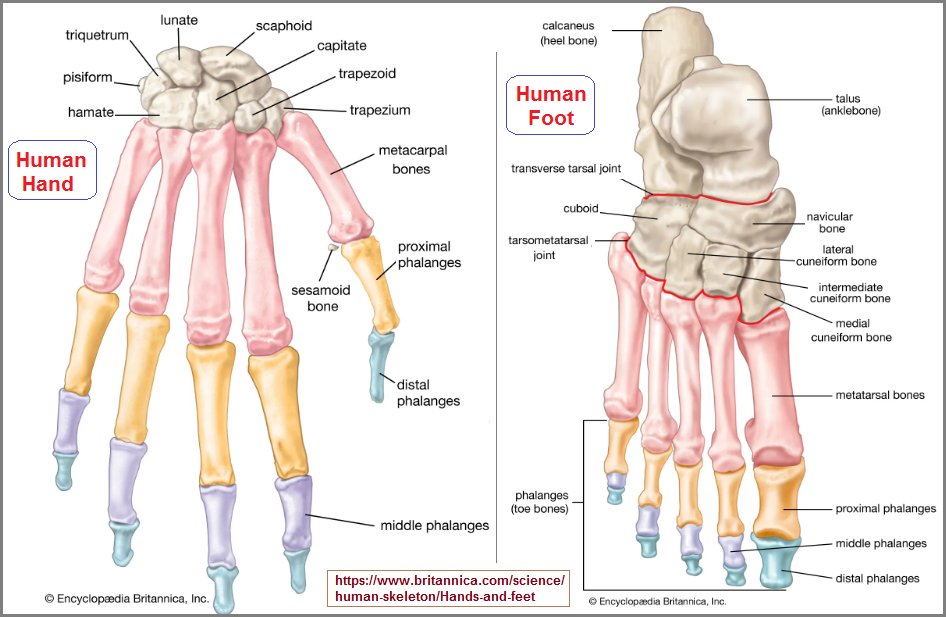
Interestingly, it is the five digits of the hands and feet that are used to construct a general body plan where other animals are included in a profiled
comparison which is called the Pentadactyl limb.
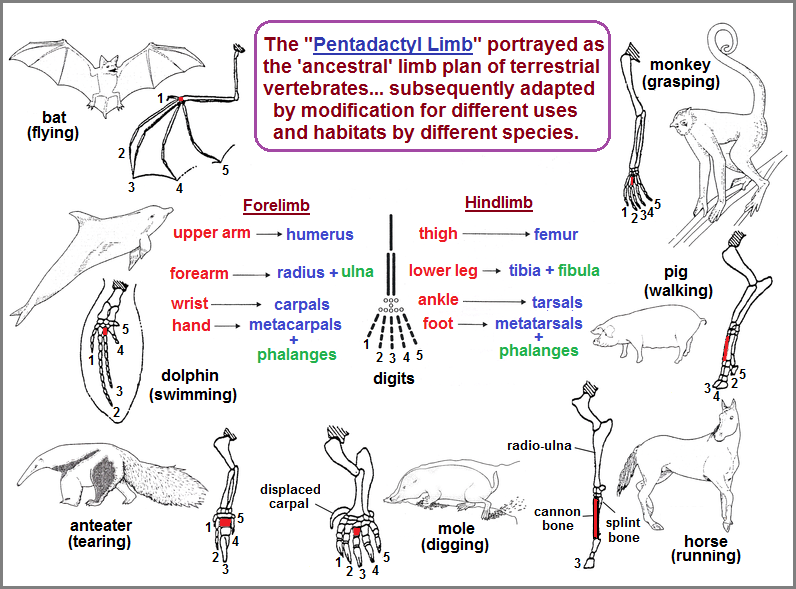
Comparative anatomists use the above illustration or some variation of it as evidence for Evolution by way of Homologous structures originating from some supposed ancestral form that all animals got their cue from and copied... at least this is how a Creationist might want to word an overview from their anti-evolution argument. If you narrowly define any word or idea, it is easy to provide evidence for some other sentiment to be advanced as one's purported truth. To me, the word "evolution" means adaptation and adoption of characteristics which arise due to environmental pressures (or absences, or inter-mittancies), that may or may not be the best survival tool, but is the best which can be developed under particular circumstances for a given type of physiology, whether or not you approve of some constricted valuation of the word "Evolution". Let us pause for a moment to take a look at how Comparative Anatomy may be undertaken by viewing three methodological topics... Namely Analogous, Homologous and Vestigial structures:
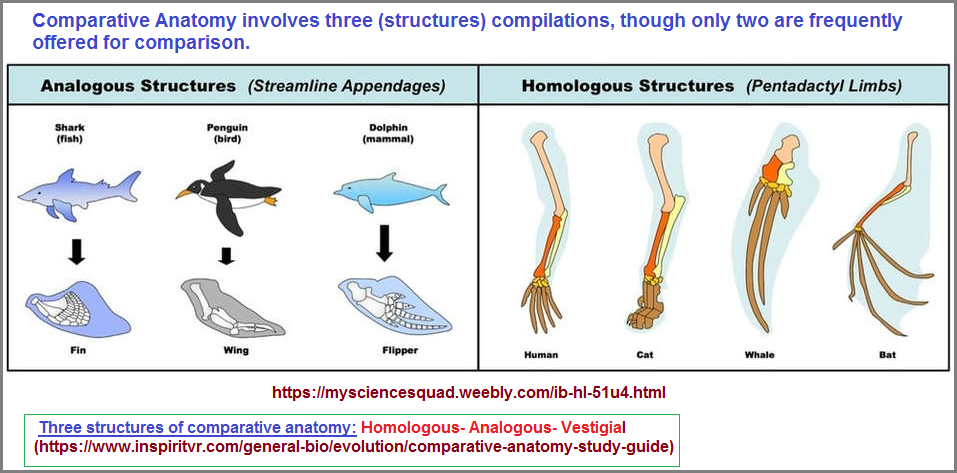
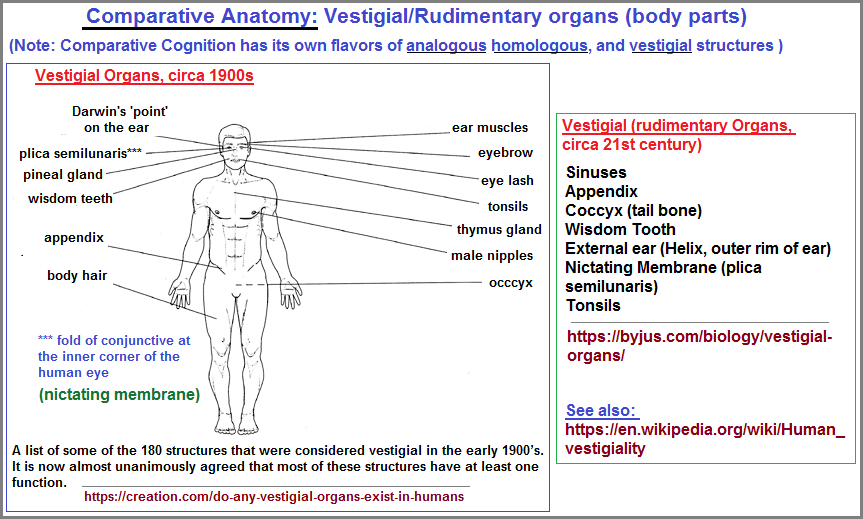
Evolution is change but not all changes need occur as some physiologically-expressed attribute which is similarly exhibited from one species to the next. Variations can occur just like characters in a story which is retold in a different culture with different language with era- and culture-specific observances whose authors may or may not want to keep the storyline as close to the original as possible. Seeing through such variations often requires some basic labeling methodology such as in the case of assigning quantity or quality which may also differ from one researcher to the next. For example, you may claim the presence of a "2" while I claim the presence of a "3", such as is analogically described in the following image:
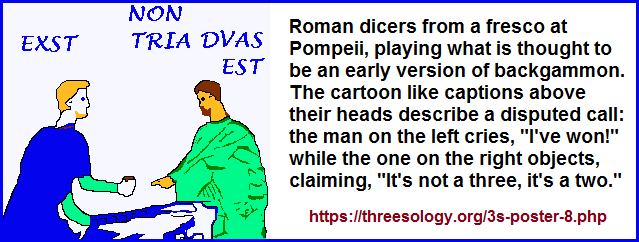
This same two versus three contention can be seen in the idea where some claim a cell has a bi-lipid layer and previously the idea was that it had a tri-laminar structure. Hence, the "bi-" is "2" and the "tri-" is "3". Yet, other numbers or symbols could just as well have a contention, as can be seen when people argue about how a word should be pronounced with a short or long vowel sound such as tomato or toe-Maa-toe. Similarly, when someone advances the view that the Earth is the 3rd planet from the Sun, one could also argue for counting the planets beginning with Pluto (that is if you count it as a planet), which purely by chance provides a count of 7. So, which is the correct way to count the planets? From left to right, up to down, inside to out, or some other numerological/philosophical derivation which includes flip-flopping one's ideas?
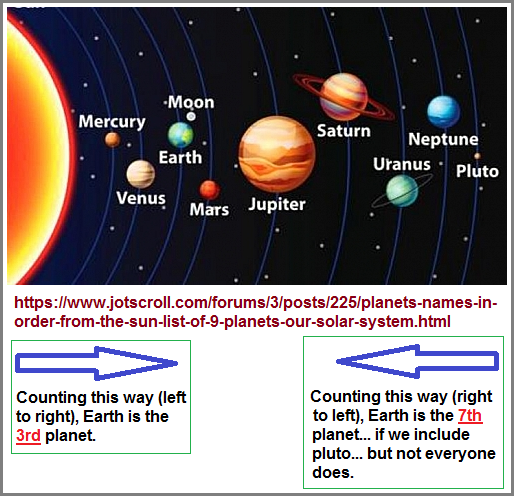
Since I am looking for repetition (as well as what appears to be inconsistencies, overlappings, mixtures, substitutions, incongruities, contrasts, inter-mittancies, absences... etc.,), I use this as a standard for analyzing different subjects. Granted I have my biases, but I do try to work through them or else someone other than myself will point out a flaw. If I am wrong, then I am wrong... and back to the drawing board. Hence, if I come across what I think is a pattern, is it one that occurs elsewhere or has a research subject been subjected to a culture of researchers who are perpetuating a similar bias and offering their view as the dominant one, since no one questions them? I don't care if every leading professional and supportive lay-person group view a context in a given way, it must be questioned. While one might have a sense that something is amiss, such as sense needs to have some illustrated representation. Saying one has a "feeling" only goes so far in a discussion. And it is equally irritating to hear or read an Astronomer or person interested in Astronomy to speak of binary planets (that I perceive as a dominant pattern being repeated), but such a view has no accompanying discussion of why the Astronomy culture uses this perspective but doesn't place this in the context of recurring cognitive patterns to rule out a subject's cultural biases and view the opinion as a representative indication of the Universe's age... in that we see in other subjects that the "2" position or expression is followed by a "3"... though reversals can take place as well as divergencies and compilations which can be misinterpreted due to an inaccurate length of time and/or context is being used as a measuring stick.
I really don't care if you follow the ideas of Evolution or Creationism or whatever, either from a philosophical, popular or scientific venue. Whichever provides the most viable and verifiable level of truth is most important. However, I know that some people get trapped by their social environments whose dominant figures expect everyone to intellectually toe the same line as they do and any variation of thought becomes suspect and may cause different measures of isolation, ostracism, denouncement, etc... If present day science and mathematics are later to be identified as superstitions just like Religion has been and is, then we must hold such "serious" subjects as being suspect of harboring and promoting nonsense. But, feeling this and saying this is not enough. One must have an alternative description supported by some sort of evidence that can be at least tentatively verifiable.
Since so many ideas from the past have turned out to be bogus, it is best to keep them as one would other types of respective tools in a tool box, kitchen drawer, shoebox, cigar box, tin can, etc... I am interested in accounting for repetitions (which includes lack thereof) whether or not those with a personal bias or prejudice want to assert some idea promoted by some ulterior motive such as religion or commercial viability. Because many repetitions are linked to man-made activities, one must distinguish between Natural and artificial forms of repetition. Whereas we might find a given culture who apparently uses a particular number (let us say "4" for example), we must note how frequent or absent it is from other cultures both present and the past. However, since most of the past is without a written record, we can only speculate as to how frequent a given number pattern was used... and documentations by historians may or may not be factual with respect to the larger populace as opposed to a profile of those ideas frequented by some leadership during one or more symbolically registered events.
Yet, if we pretended we were from the future looking back on the present day American culture which contained only a few fragments of books, magazines and movies; would we be able to decipher the dominant pattern of number (s) expressed in the day -to- day lives of the populace? Does the three branches of government represent a dominant cognitive theme of the overall population, and can we look at all cultures in the same way? If this is true of a Tricameral government arrangement, is it true for Bicameral and Unicameral formulas as well? However, the use of the words Unicameralism, Bicameralism, Tricameralism in a political sense are reserved for the design and functionality of Legislatures, such as the U.S. state of Nebraska with its Unicameral model. The three branches of government in the U.S. (Executive- Judicial- Legislative) are not typically cited as an example of Tricameralism.
In the Bicameralism citation of the wikipedia we find the comment "As of 2015, about 40% of world's national legislatures are bicameral, and about 60% are unicameral." This leaves no one practicing a Tricameral legislative model which a Cenocracy model advocates as a replacement based on some jury-duty illustrative association.
Date of (series) Origination: Saturday, 14th March 2020... 6:11 AM
Date of Initial Posting (this ): 1st March 2022... 6:04 AM
Updated Posting:Saturday, 5th November 2022... 6:39 AM, AST (Arizona Standard Time); Picture Rocks, AZ.